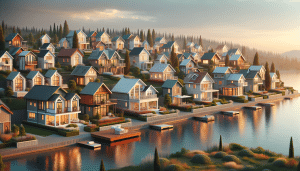Why You Might Love Living in a Mixed Use Community
Emily Clarke October 23, 2025
Considering mixed use communities can offer advantages that surprise many home seekers. This guide explores the appeal, amenities, values, and affordability factors behind these popular living environments and what potential residents should understand before making a choice.
The Rise of Mixed Use Communities
Mixed use communities are transforming real estate and housing conversations everywhere. These spaces blend residential, retail, and sometimes office or recreation into a single, walkable area. Residents enjoy having cafés, gyms, small shops, and even workplaces nearby, supporting daily routines without long commutes. For urban planners and property developers, the shift toward mixed use zoning is driven by growing interest in neighborhood cohesion and flexibility. Home buyers searching for modern housing trends often encounter mixed use developments as highly desirable options with strong appeal.
Local governments increasingly encourage mixed use development because it brings vibrancy and economic resilience to city neighborhoods. When multiple functions—living, shopping, working—coexist, there’s a boost to local businesses as more foot traffic flows through the area. This environment fosters a natural sense of safety, too, since more people come and go at different hours. Many mixed use buildings consciously design ground-level space for small businesses and service providers, while upper floors serve as housing or offices. Walkability and access to daily needs become real selling points for buyers and renters interested in sustainable urban lifestyles.
The convenience of mixed use communities does not just benefit city dwellers. Suburban and even rural regions are also exploring new mixed use housing options in response to changing demands. People want compact, connected living where errands take minutes, not hours. This style of community design can help ease the growing pains of expanding cities and provide affordable housing alternatives by integrating multiple land uses within one project. Prospective home buyers, investors, and tenants increasingly ask how a neighborhood fosters walkability, social connection, and easy access to services—qualities that mixed use communities naturally promote.
Amenities That Add Value in Mixed Use Housing
A key reason people look for mixed use communities is the wide range of amenities. Essential services—such as grocery stores, pharmacies, gyms, and medical offices—are often steps away from residential units. These amenities shape daily routines and make mixed use complexes feel like complete neighborhoods, not just a collection of buildings. Residents enjoy being able to pop out for coffee, find quality dining experiences, or enjoy entertainment without using a car. This blend of convenience, social benefits, and reduced travel needs supports both active lifestyles and aging in place strategies.
Some mixed use developments push the amenity model further with innovative extras, including rooftop gardens, pet-friendly parks, children’s play areas, and community meeting spaces. These features foster daily interaction, making it easy for neighbors to meet and local businesses to flourish. Developers often curate amenities to attract specific buyer or renter demographics: young professionals may prioritize coworking spaces, while families desire safe, green areas and strong school access. These wide-ranging options add tremendous value to both owners and tenants—and explain the consistent demand found in mixed use property searches.
For older adults, mixed use housing offers a way to remain independent and socially connected without giving up access to healthcare or community support. Many new projects intentionally link residences with wellness centers, clinics, and even cultural programming. This design supports a healthy lifestyle for all ages, while integrating medical, recreational, and everyday amenities in a cohesive and inclusive fashion. As a result, mixed use communities often see higher rates of resident satisfaction and engagement when compared with isolated suburban or single-use environments.
Affordability and Housing Options in Mixed Use Developments
Affordability is a driving factor for home seekers and renters researching mixed use communities. Housing in these areas often comes in a variety of forms—apartments, townhouses, condos, and sometimes affordable housing units or workforce housing. This diversity of options lowers barriers to entry for a wider range of residents. By blending retail and residential, mixed use developments can often support below-market-rate units, balancing commercial rent income against lower residential prices. Financial incentives for affordable housing in mixed use projects may come from public-private partnerships or municipal grant programs that encourage socially responsible growth.
The pricing structure in mixed use neighborhoods is shaped by several factors: location, the number of amenities available, and the integration of transit or walkability features. For instance, units above commercial areas may be priced lower than those with private courtyards or rooftop views. Savvy buyers and renters ask about homeowner association fees or community maintenance costs, which sometimes offset the reduced transportation and utility expenses gained from living in a convenient, centrally located space. Extra keywords like “affordable housing grants” or “housing incentives” help residents find these opportunities in search engines when researching where to live.
Another trend driving affordability in mixed use developments is the rise of micro-units and flexible living arrangements, such as co-living. These options attract students, young professionals, and downsizers seeking economical, yet well-connected living experiences. Smaller living spaces allow for more communal amenities and shared resources—like laundry facilities, shared kitchens, or creative lounge spaces—helping keep monthly living costs manageable. As mixed use communities grow, developers often work with local governments to include dedicated affordable housing, ensuring these vibrant spaces remain accessible to people from various income levels.
Community Impact and Social Dynamics
The design of mixed use communities isn’t just about real estate—it’s about fostering robust social interaction. Placing homes near parks, retail spaces, and offices encourages residents to walk, gather, and build connections organically. Events like local markets, pop-up shops, or outdoor concerts further enrich community life and create frequent opportunities for neighbors to meet and support one another. Research suggests these social bonds lead to safer communities, reduced loneliness, and higher civic engagement, making mixed use developments a popular study topic in urban sociology and community planning.
The diverse housing types and shared public spaces within mixed use projects often support a more inclusive neighborhood. This inclusivity isn’t only demographic—economic diversity flourishes when a variety of residential price points coexist with jobs, services, and retail options. Such built-in diversity has long-term positive effects on public health and socioeconomic mobility, according to multiple nonprofit and academic studies. When residents of all ages and backgrounds have reasons to be in the same public spaces, divisions soften, and a genuine sense of community flourishes—a key aspect for those prioritizing belonging in their search for new housing.
Environmental stewardship forms another aspect of the social benefits connected to mixed use neighborhoods. Emphasizing walkability, transit access, and shared resources, these communities support more sustainable, low-carbon choices by making cycling, walking, or taking transit practical alternatives to daily driving. Buildings are frequently constructed to higher energy standards, with green roofs, solar panels, and water-saving landscaping. This commitment to sustainability isn’t just good for the environment—it galvanizes residents around a collective purpose, boosting pride and involvement in community initiatives.
Searching for the Right Mixed Use Community
Finding a mixed use community that aligns with personal priorities takes research and thoughtful evaluation. Prospective residents can start by identifying which amenities matter most—access to schools, healthcare, parks, or even pet services. Reviewing the master plan of a neighborhood helps clarify how residential, retail, and public spaces interconnect. Some communities prioritize wellness features or eco-friendly infrastructure, while others excel at cultural programming or inclusive design. Online search trends show an increasing interest in mixed use community features such as “live-work-play,” “walkable neighborhoods,” and “community amenities.”
It’s wise to visit potential communities at different times of day, observing the rhythms of daily life. Is there a vibrant café scene in the morning? Are parks and community centers busy and well-maintained? Talking to current residents or property managers can provide invaluable insight into how the development operates, from safety and cleanliness to levels of engagement. Many cities provide public access to planning documents or vision statements for new mixed use areas. Reviewing these materials allows home seekers to understand future growth plans, regulatory frameworks, and how affordability is measured and managed.
Technology helps narrow the search for the perfect community. Many real estate portals now highlight mixed use projects with search filters for amenities, sustainability certifications, or retail integration. Social media and neighborhood apps offer platforms for gathering real-time feedback about a specific building or development. Along with official listings and planning documents, firsthand testimonials can reveal whether a community meets everyday needs and supports a connected, enjoyable lifestyle. Expectations and realities differ, so thorough research remains the foundation for happy transitions into mixed use living.
Future Trends in Mixed Use Real Estate
The popularity of mixed use development is leading to new innovations. Upcoming trends reflect both changing household types and a desire for flexible, resilient neighborhoods. As remote work continues to evolve, many mixed use communities are incorporating flexible leasing, advanced coworking amenities, and robust tech infrastructure to suit different work-life needs. Efforts to integrate more nature and green infrastructure—like community gardens, walking trails, or pocket parks—grow alongside digital connectivity features. Search data show increasing curiosity about “smart developments,” “energy-efficient homes,” and “flexible living.”
Health and well-being will likely shape future mixed use housing, with a focus on indoor air quality, wellness-oriented amenities, and access to open space. Developers and planners are responding with touchless building systems, outdoor gathering areas, and comprehensive wellness programming. Another significant trend is the revitalization of older commercial centers into vibrant mixed use hubs, which preserves resources while meeting demand for housing and services in established neighborhoods. Some regions are also seeing zoning updates that support even greater density and flexibility, unlocking new opportunities for creative urban living.
Continued collaboration among developers, city planners, nonprofit organizations, and residents is critical for advancing the benefits of mixed use real estate. Grant funding for affordable housing, transportation upgrades, and green space enhancements helps ensure that mixed use developments remain accessible and sustainable. Innovations in financing and policy will further support growth and diversity in mixed use neighborhoods. For those exploring where to move next, these upcoming shifts promise a dynamic and inclusive approach to community life—one that truly adapts to modern needs and evolving values in the housing market.
References
1. Urban Land Institute. (n.d.). Mixed-Use Development: A Smart Growth Trend. Retrieved from https://americas.uli.org/research/centers-initiatives/urban-resilience-program/community-resilience-hub/mixed-use-development/
2. U.S. Department of Housing and Urban Development. (n.d.). Evidence Matters: Mixed-Use Development. Retrieved from https://www.huduser.gov/portal/periodicals/em/spring13/highlight1.html
3. American Planning Association. (n.d.). Planning for Mixed Use. Retrieved from https://www.planning.org/knowledgebase/mixeduse/
4. Harvard Joint Center for Housing Studies. (n.d.). The Changing Landscape of Mixed Income and Mixed Use Communities. Retrieved from https://www.jchs.harvard.edu/blog/the-changing-landscape-of-mixed-income-and-mixed-use-communities
5. National Association of Realtors. (n.d.). On the Rise: Mixed-Use Developments. Retrieved from https://www.nar.realtor/commercial-member-outlook/on-the-rise-mixed-use-developments
6. National Low Income Housing Coalition. (n.d.). Affordable Housing in Mixed Use Developments. Retrieved from https://nlihc.org/resource/affordable-housing-mixed-use-developments







